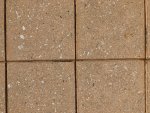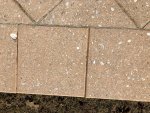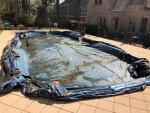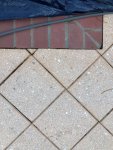Hello Everyone,
This is my first forum. Please help. Coming to you from Memphis, TN with questions and pics about what to do about my small grout joints on my pool deck. I have a concrete pad with what appears to be coral stone pavers with beveled edges mortared in place with no sand underneath nor room for poly grout in between the pavers except for the pavers around the pool perimeter which have what looks like mastic or mortar between them(see pics). There is also a 1/8 inch gap between pool brick coping and the first row of pavers. Most everywhere else, joint spaces are 1/32-1/16 of an inch. Pool was installed in 2004. When I purchased the house 3 years ago, 100 or so pavers were loose around the pool coping. I had them re-mortared. Deck appears to be holding up fine since. Two years ago I tried adding polymeric sand but 90% of it washed out because it just sat in between the beveled edges and did not have room to fall in and bond in the joints between most of the pavers.
My questions,
1. Is grouting the joints even necessary since the pavers are mortared in place? If not, great! I just wanted to do whatever is necessary to extend the life of my pool anyway.
2. If something needs to be done, what should I put in between the pavers since polymeric sand needs 1/8 inch to work and I do not have that much space?
3. What material is that in between the pavers along the pool edge in the pic attached?
4. Once I address the grouting questions above, I plan to seal the pavers with Eagle high gloss concrete sealer. Is that a good idea?
This is my first forum. Please help. Coming to you from Memphis, TN with questions and pics about what to do about my small grout joints on my pool deck. I have a concrete pad with what appears to be coral stone pavers with beveled edges mortared in place with no sand underneath nor room for poly grout in between the pavers except for the pavers around the pool perimeter which have what looks like mastic or mortar between them(see pics). There is also a 1/8 inch gap between pool brick coping and the first row of pavers. Most everywhere else, joint spaces are 1/32-1/16 of an inch. Pool was installed in 2004. When I purchased the house 3 years ago, 100 or so pavers were loose around the pool coping. I had them re-mortared. Deck appears to be holding up fine since. Two years ago I tried adding polymeric sand but 90% of it washed out because it just sat in between the beveled edges and did not have room to fall in and bond in the joints between most of the pavers.
My questions,
1. Is grouting the joints even necessary since the pavers are mortared in place? If not, great! I just wanted to do whatever is necessary to extend the life of my pool anyway.
2. If something needs to be done, what should I put in between the pavers since polymeric sand needs 1/8 inch to work and I do not have that much space?
3. What material is that in between the pavers along the pool edge in the pic attached?
4. Once I address the grouting questions above, I plan to seal the pavers with Eagle high gloss concrete sealer. Is that a good idea?
Attachments
Last edited by a moderator:





